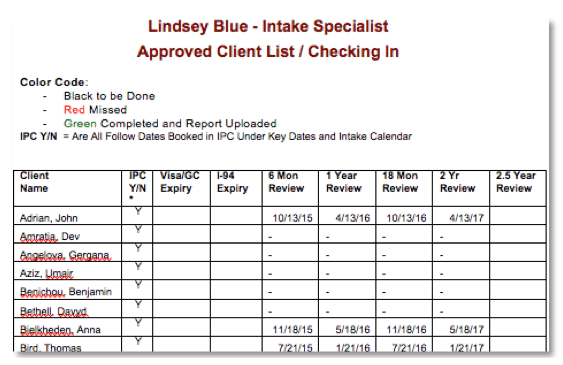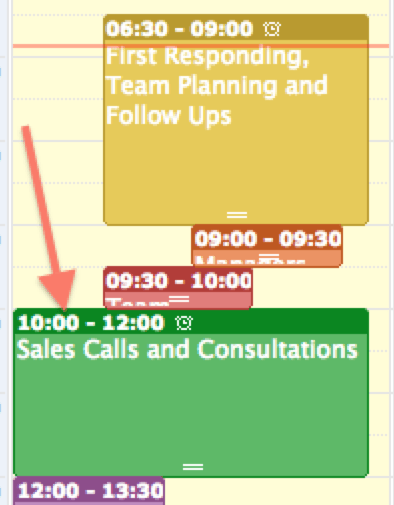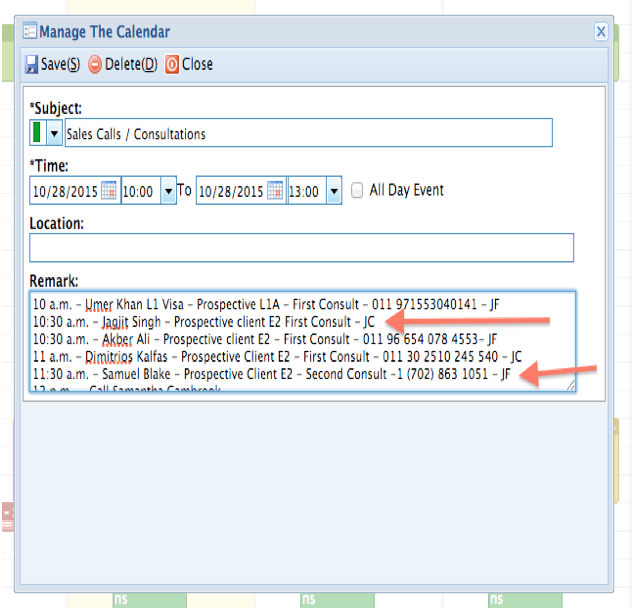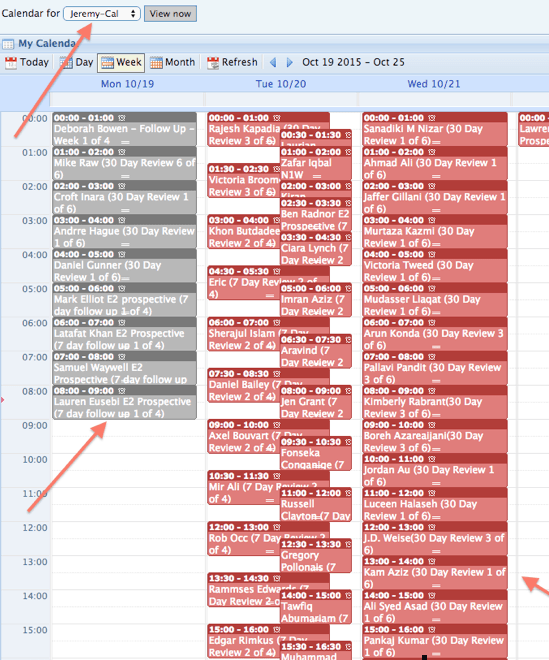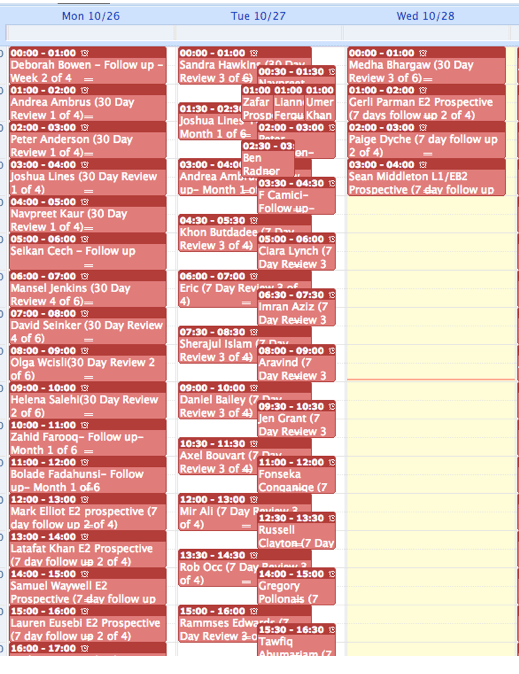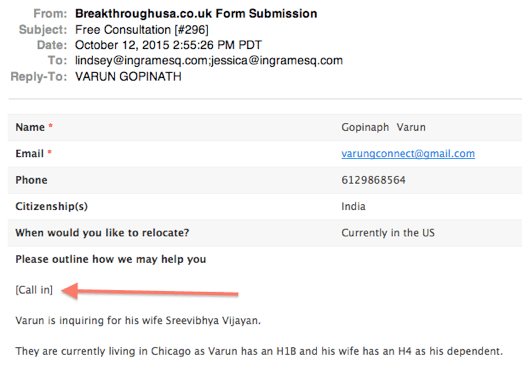Intake Assistant – Working It!
Part 1 – Part 2 – Part 3 – Part 4 – Part 5 – Part 6

Working It!
Your Role
In the last presentation we covered how we get leads but how we record them and track them. Now we have to get into how in your role as an Intake Assistant you will be responsible to taking these leads and indeed existing clients and making sure that you book all of them onto Intake Specialist’s calendar.
In other words, it is your job to ensure that the Intake Specialist is able to speak to as many people as possible in a given day, as well as ensure there is a variation of the types of consultations the Intake Specialist has to work through. So let’s take a look at the various types of consultations you will be required to schedule.
Types of Consultations
There are four basic types of consultations the Intake Specialist is responsible for: –

The Practice Manager, Shirin receives all new leads as they are submitted through our BreakthroughUSA.com website. once received Shirin will then assign the lead to the appropriate Intake Specialist and the Intake Assistant.
When you, as the Intake Assistant, receive your lead your job is to check to make sure you have a phone number and if so call the lead with a view of setting up a consultation with your Intake Specialist.

Before you call the lead run it by your Intake Specialist and discuss the lead. Maybe the Intake Specialist may give you specific instructions as to how to make the call or what questions to ask whilst on the call.
If you have a bunch of leads given to you in the morning then you might want to run through them all in one go with your Intake Specialist before you call them.

Another type of First Consultation would be with former clients who have already been approved for a visa or green card, and now require additional legal work. The additional legal work could include any number of processes, but are most likely to be one of the following:
(1) Extension of their current visa;
(2) Green Card review; or
(3) U.S. Citizenship.
Each time an Intake Specialist speaks with an approved client about a new legal process, it is considered a first consult.

Don’t worry as long as you work your SAR you’ll be fine.
b) Second Consultation – The second consultation will often be set by the Intake Specialist while they are on the phone with a prospective client during the first consult. We generally strive to set the second consultation within 1 – 2 weeks of the first consultation, no matter the timeline of the client. Setting the second consult within 1-2 weeks of the first consult allows us to get a full picture of the clients’ concerns, needs, and desires to move forward. As such, we encourage the Intake Specialist to close the first consultation by setting a second consultation within the 1 – 2 week period. However, this might not always be possible.
As the Intake Assistant you will be need to follow up with your Intake Specialist to find out if a second consult was booked so you can then up date your SAR and the Intake Specialists calendar – or if no second consult was booked you need to find out why, there could be nay number of reasons why the second consult was not booked. E.g., The prospects calendar for the new few weeks was very busy. So you need to talk to your Intake Specialist to get direction so that you can set a follow up within the next 30 days where you would try and get that prospect back on the the Intake Specialists calendar so they can pick up where they left off.
One of you most important jobs as an Intake Assistant is to make sure leads do not fall through the cracks.
.
Post Consult Reports (PCR)
After each consultation the Intake Specialist should write a PCR to the prospect to outline the conversation and what the plan was moving forward. These PCR are very important because weeks after the initial consultation its very easy to forget how the conversation went. The PCR should be written the same day or at the latest the next day. As the Intake Assistant you need to make sure that that these all get done (sometimes the IS can get distracted and forget – so you must be their memory). PCR are also recorded on the Lead Register.
.
Making Sure You Stay On Top of Following Up

Once the second consultation has been completed, we may have a very clear timeline with regard to the clients’ plan to retain the firm.
During the time between the second and third consultations, the Intake Specialist will be following up to check-in with the client in an effort to keep them engaged with the firm. In order to achieve this you will need to make sure that at a frequency agreed with your Intake Specialist that you get the prospects booked back into the IS’ calendar. As outlined above your job will be to make sure that the IS has a full calendar with a good blend of 1st, 2nd and 3rd+ consultations, plus a good blend of calls booked to speak with existing clients with whom we need to stay in touch.
Each prospect is different, and while some will stick to their original timelines, others will have issues that may prevent them from retaining according to their original schedule. For example, illness in the family, an unexpected event, perhaps their house did not sell as they’d hoped, etc. So what every the issue, your #1 goal is to make sure you do not miss a beat and you re-schedule and re-book as needed to keep your Intake Specialist busy.

Approved clients are not to be neglected by any means, because they can become a significant source of new business when managed appropriately. All of these opportunities should be tracked in your SAR. If your SAR does not have data, then discuss with your Intake Specialist as to where you can go to search out this information so you can populate your SAR accordingly.
.

A primary aspect of your role as an Intake Assistant is managing the number of consultations an Intake Specialist has on their calendar.
When you schedule calls for an Intake Specialist, you must consider a margin of error for those clients who do not answer the phone or must reschedule due to a conflict. Unavailable clients are apart of the nature of the business, and will not change. It’s a good idea therefore to have backup consults so that if a booked consult is a “no answer” you have a go to lead or client you can call at short notice to get on the calendar.
Also, you can call or email your leads or clients the night before to remind them of their appointment and to let you if they cannot now keep that appointment.
So your goal is to make sure that the number of kept consultations is as high as possible.
.

It is important for the Practice Manager to be able to track your activity, and the activity of your Intake Specialist. Aside from the constant communication between all team members, the Practice Manager still needs to be able to see your activity ‘at a glance.’ To ensure that your activity is readily apparent, there is a specific way you should be booking consultations: –
a) Proper Format for Calendaring Calls
The Intake Specialists’ calendars have their call slots marked in green, as such:-
.
.
In this time block, an Intake Specialist will have a number of available appointments. You will need to open this box, and schedule the individual calls within the notes section of the Sales Calls / Consultation box. Calls are made in 30-minute increments. Do not make changes to the subject box.
.
.
The general format for booking appointments is as follows:
– [Time]
– Client Name
– Prospective [Visa Type]
– [#] Consult
– Phone Number
– Initials
Following this format, specifically noting your initials, allows the Practice Manager to keep track of who is booking the consultation.
In the example illustrated above, Jessica (JC) scheduled several first consultations. However, the 11:30 a.m. slot indicates that Jeremy (JF) made a second consultation appointment himself (which, again, will likely be the case since Intake Specialists will schedule the second consultation with the client during the first consultation).
Every single call booked into the calendar should reflect this format. If your Intake Specialist books a call that does not follow this format, please work with them to ensure it is changed to follow the above format.
Double-Booking the Intake Specialist
Many times, when you are attempting to make an appointment, the client will not confirm. Additionally, many of the inquiries do not provide a phone number, and thus we will need to request it by scheduling an appointment via email.
In these instances, it is important to have a ‘back-up’ appointment for the Intake Specialist to ensure they are maximizing their time on the phone. When you ‘double book’ a client, you will need do the following: –
1: Double book the client on the calendar at the appropriate time; and
2: Inform the client that the Intake Specialist has a tentative opening at that time, but in case the Intake Specialist is unavailable, the client will receive a confirmed appointment for a later date.
Following this method will ensure that your Intake Specialist has a back-up plan for an unconfirmed appointment, and the client will have the opportunity to speak with the Intake Specialist.
.
Managing the Follow-up Calendar
As discussed, your Intake Specialist has a number of follow-ups booked into their calendar on daily basis. You will be responsible for managing the follow-up calendar and ensuring that the client’s case is reviewed, a note is made and/or an email is sent according to the needs of the client.
The follow-ups are initially booked on the Intake Specialist’s follow-up calendar in red. Each Intake Specialist has a second calendar labeled ‘Cal’ after their name. For example, Jeremy’s follow-ups can be found on the calendar labeled ‘Jeremy-Cal’.
Once a follow-up is reviewed and attended to, you will turn it to gray, indicating it has been completed for that day. Below is an example of Jeremy’s follow-up calendar with both complete and incomplete follow-ups:
.
.
Here, at the end of the day on Monday, October 19, 2015, we see that Jeremy’s follow-up calendar is up-to-date. Ensuring this is done will be part of your daily activity.
Even Number of Follow-Ups
When the follow-ups are booked into the calendar, it generally corresponds with the day of the week that the inquiry was initially received. Because the inquiries can vary daily, it can lead to an uneven amount of follow-ups each day, as is evident in Jeremy’s calendar.
.
.
Having an uneven number of follow ups to wrangle can create an undue burden that may prevent you from completing all of the scheduled follow-ups, which in turn starts a pattern of falling behind on the follow-ups. Such a pattern of falling behind is a negative result we want to avoid.
Since adjusting a follow-up by a day or two will not negatively affect the system, you will be required to review the Intake Specialist’s follow-up calendar and even out the number of follow-ups per day.
As you can see from the image of Jeremy’s calendar above, he has several days with 20+ follow-ups, which is a great deal of work. Further, you can see the imbalance in his schedule as he has one day with only 4 follow-ups.
Keep in mind that even when you ‘even out’ the follow-ups so that there is a consistent number each day, there will likely be quite a few per day. This is ok. The idea is to balance out the workload so that we can properly schedule the correct amount of time needed to complete the follow-ups.
In order to assist the Intake Assistant, the Intake Specialist will provide the Intake Assistant with template emails for the various situations of the prospective clients. Intake Assistants will need to maintain a high level of care and engagement with the prospective client, and will be required to review the correspondence in the case file.
Upon reviewing this correspondence, the Intake Assistant will select the most applicable email as provided by the Intake Specialist. In the event that an Intake Assistant is unsure as to which email is appropriate, they should confer with the Intake Specialist to make a determination.
Please see Appendix A for follow-up email templates. Please bear in mind that these will help you significantly, but are not always appropriate. If you are at all unsure, please confirm with the Intake Specialist before sending the email.
.

Most of the time the reception staff will answer each and every phone call but occasionally you may need to take a call. If it’s an inquiry call basically here is the protocol you must follow:
1: Open our main website www.breakthroughusa.com
2: At the start of the “Please outline how we may help you box type in [Call In:] so we know that this lead was via someone calling into the office.
3: Ask the caller the questions in the inquiry form and get as much information as you can and then hit submit.
4: Assure the caller that we’ll get back to them asap.
The Practice Manager will automatically get the lead and distribute the lead to the appropriate person.



